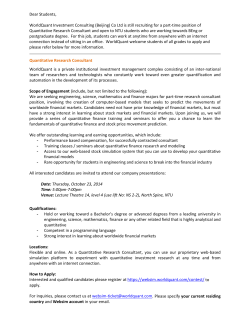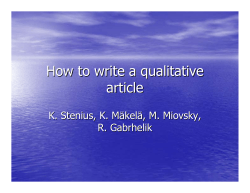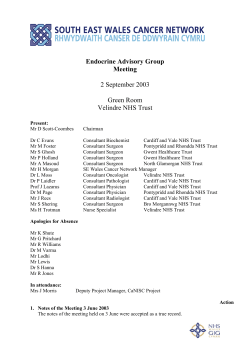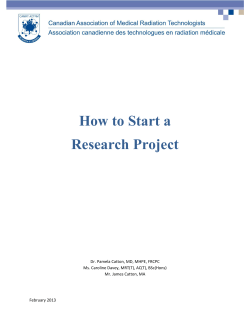
HOW TO REVIEW CONSULTANCY REPORTS
HOW TO REVIEW CONSULTANCY REPORTS Version edited 16/01/2013 TMEA and TMEA’s partners frequently contract consultants to conduct baselines, develop strategies, deliver training, design policies, undertake research and write reports. Consequently, it is essential to ensure that the outputs are relevant to your work, methodologically sound, and of a high quality. To achieve this, you must carefully review each consultancy report and give appropriate feedback. This report outlines key factors to consider when reviewing consultancy reports, illustrates this with three (fictitious!) examples, and briefly discusses how feedback should be managed. It accompanies the main TMEA monitoring guidelines, which can be found here. Overall guidance: Take time. Reading a report properly (not just the executive summary and conclusion) requires time and effort. Go somewhere that you will not be disturbed, turn off your mobile phone and email, and read through the full report carefully. Be respectful, but demanding. Consultants are expected to possess experience, professionalism and knowledge. However, never assume that they are always correct. There are many examples of sub-standard consultancy reports – ensure that yours is not one of them. From bloodandmilk.org Consult stakeholders. Give everyone involved the chance to give feedback, including TMEA staff, partners, or government agencies. Set deadlines for collecting feedback and ensure that they are met. Use TMEA colleagues who have relevant experience and knowledge. Colleagues can review consultancy reports, or suggest other sources of information. The K&R team may also be able to help with issues like logic and clarity of reports, or research methods. Step One: Did the Consultancy Achieve Its Objectives? This is a crucial question. A fascinating, well-designed and thoughtful report is useless if it does not meet your objectives. Before reading the report, reread the original terms of reference. Remind yourself exactly what you asked the consultant to do, and ask whether the terms of reference really captured the purpose you had in mind. While reading the report, consider the following points: Completeness. Ensure that the consultant requirement specified in the terms of reference. fulfilled every Audience. Briefly think about the intended audience. Is the language and style of the report appropriate for them? For example, jargon may only be comprehensible to specialists. EXAMPLE ONE – Customs Reform Baseline You have commissioned a baseline study into your customs reform project. The aim is to establish the time it took to process imports before the start of the project, in order to provide a comparison point for the time taken at the end. (For more on baselines, see the how-to guide here.) The project has been running for a while, so you have asked the consultant to use historical data to establish the baseline. The initial draft report contains a glowing assessment of your work so far. Having spoken to numerous stakeholders in the public and private sector, it concludes that all stakeholders believe that it now takes less time to process customs goods. The report also suggests several important areas for improvement, and gives valuable suggestions for future work. Are you happy with this report? What potential issues might there be? How would you deal with this? Take a moment to think about this, and then see our thoughts below. ____________________________________________________________________ Although the information provided was valuable (and encouraging), it did not address the issue you specified. The aim was to get baseline data – not to evaluate the positive or negative effect of the project. Moreover, the consultant appears to have relied principally on stakeholder interviews, while quantitative analysis may have been more appropriate. Although their report may contain valuable insights, it will not help establish the impact of your project. In this case, it would be necessary to meet with the consultant to review the terms of reference, and highlight areas where you feel information is missing. Explain how you plan to use the report, and why the baseline is important. Ask to see a second draft before receiving the final report. Step Two: Is the Methodology Sound? It is necessary to evaluate the strengths and limitations of the methodology. There is no perfect In this case,but the consider consultantwhether has not the donetechnique the job you requested. The aim wasfor to get methodology, selected is appropriate the baseline research data – not to evaluate the positive or negative effect of the project. Moreover, they were questions. If you are uncertain, then ask a colleague or the Knowledge and Results team for further asked to analyse data, but they appear to have relied principally on stakeholder interviews. guidance. Consequently, their findings cannot be compared against results from your planned end-ofThisproject sectionevaluation. briefly describes three broad methodologies; reviews,itqualitative research, Although their report may contain literature valuable insights, will not help you and establish quantitative research. the impact of your project. Literature The purpose of the literature is to identify what relevant In this Reviews. case, it would be necessary to meet review with the consultant to review the information terms of already exists. You should have completed a brief literature review before commissioning the reference, and highlight areas where you feel information is missing. Give more detail about consultancy, but they will often be expected and are strengthen the expected methodology, and the waytoindeepen which you planningit.on using this information. Ask them to submit a second draft for approval before moving on to the final draft. It is important that the literature review does not simply repeat the literature. It should analyse it; stating emerge, and highlighting of consensus disagreement. so doing, Youthe maythemes wish tothat review the terms of referenceareas to ensure that youorwere sufficientlyIn clear about it your expectations. should evaluate the quality of the documents reviewed. It should actively link the literature review back to the question posed in the terms of reference, and to the conclusions that the report will draw. Quantitative research measures the situation in numeric terms. It often uses closed-ended questions with limited potential responses, and employs statistical techniques to detect significant differences between different groups of respondents. It often requires large samples, weighted to represent the population that the study is interested in. Good quantitative analysis should use a large enough sample size to justify their conclusions. A survey of two people, for example, would not tell you very much. The study should justify the sampling methodology, following national or international standards where appropriate. Any assumptions that are made in the quantitative data analysis should be explicitly listed and justified. For example, TMEA frequently assumes that a reduction in time to trade in East Africa leads to a reduction in cost. Studies that rely on that assumption should make this explicit, say how much they assume each day of delay costs, and reference their sources for this assumption. Limitations in the analysis should be clearly explained. Qualitative research seeks to uncover the context, perceptions and quality of, as well as opinions about, a particular experience or condition. Data collection methods are likely to employ a more participatory approach through the use of open-ended questions that allow respondents to expand on their initial answers and lead the discussion towards issues that they find important. Samples tend to be smaller. Good qualitative analysis should explain who was interviewed, and why they were chosen. When reading, consider whether they are appropriate for the report’s purposes. The consultant should describe the instrument that was used, how it was designed, and how the results were analysed. In practice, reports are likely to use elements of all three methodologies. The literature review is essential to learn from previous work, and ensures that you contribute something new. Quantitative data measures the extent of a problem, and provide a simple understanding of how it has changed. It tells you what happened, when, and to who. Qualitative data will supplement this with insights from partners, beneficiaries and staff, addressing the causes, sustainability, and impact of this change. This explains how and why things happen Whichever methodology is used, the consultant should be explicit about what they did, and how they did it. They should be willing to provide you with tools used (such as questionnaires or workshop guides), and the raw data from their analysis (either quantitative information, or transcripts from interviews.) Moreover, they should be clear about the limitations of the research. Perhaps most importantly, the analysis and recommendations should clearly link to the literature review and primary research. It should explain the findings, make explicit the relevance to the problem defined in the terms of reference, and explain the implications for your programme. This section has only given a brief snapshot of ways to critique research. A short and readable guide on quantitative research is available here and on qualitative research here. Although originally designed for medical students, they are applicable to any research projects. See Annex One for examples of specific methods that can be used. Step Three – Other Factors to Consider There are numerous signs of a high-quality report, and only a couple are listed here. They include: Spelling, grammar, and layout. The report should be professionally presented, with correct spelling and grammar. Jargon should be avoided where possible, and the language should be clear and accessible. Executive summary. Every report should start with an executive summary. This will be the only section many people read. References. A good report should cite its references, in footnotes or a bibliography. Assertions should be backed up with sources, so you can check where they get their facts from. Length. The shorter the report is, the more likely it is to be read. Sections irrelevant to the main purpose should be cut out. If relevant but lengthy or specialised, then they can be put in annexes (for example, detailed methodology descriptions, or questionnaires). EXAMPLE TWO – Communicating Regional Integration The Knowledge and Results team commissioned a report into the economic effects of regional integration, designed for a wide audience. The executive summary contained the following points: Kenya, Rwanda and Burundi are likely to have benefited from convergence to the CET due to reductions in MFN tariffs. However, the results suggest that the degree of IIT in the EAC region is relatively low Using an indicator of import similarity to gauge the degree of source switching between preferential and non-preferential partners gives evidence of some trade diversion occurring. What are the potential issues with this report? How might you solve them? Take a moment to think about this, and then see our ideas below. ________________________________________________________________________________________________________________________________________________________________ The report sounds like it is well-researched and detailed. However, it is not easily understandable by a non-economist. The executive summary should be the most accessible part of the report, since it is likely to be the most widely read section. The current terminology will limit the audience of the report, and so reduce its impact. Meet with the consultant to emphasise the importance of readability and accessibility. Highlight areas in the report which you feel meet these criteria, to provide a model for the rest. Consider providing an example of a report that successfully balances complexity with readability. Review the final draft when it arrives, to ensure that they complied with this request. You could consider summarising the report when you email it round, to help other readers understand the main points. Alternatively, other methods of reaching wider audiences – like policy briefs or short overviews – could be produced and disseminated. Step Four – Give Feedback to the Consultant When giving feedback to the consultant, consider the following points: Feedback should be phrased constructively – highlight the positive aspects of the report as well as those that you believe need to be adjusted. It may be wise to ask for a second draft of the report before receiving the final version, to give an additional opportunity for improvements to be made. Follow up on comments to ensure that they are addressed in the final draft of the report – don’t assume that they will be. Finally, if the consultant does not deliver what you wanted, evaluate whether your expectations were realistic. Perhaps you asked for too much, or the terms of reference did not specify exactly what you wanted. If you have a bad experience with a consultant, think about how you can learn from it. EXAMPLE THREE – Advocating for Weighbridge Removal Your team advocates for the removal of weighbridges in East Africa. You commissioned initial research to help design your advocacy strategy. The consultant surveyed 400 truck drivers, and statistically analysed differences between countries. They show which countries have the most weighbridges, how long drivers spend at them, and how much this costs businesses. The report is clearly well-researched, and the consultant explains their methodology clearly. What are the potential issues with this report? How might you solve them? Take a moment to think about this, and then see below for our answers. _______________________________________________________________________ There are many positive aspects to this report. However, it may not provide new information. Previous reports have highlighted that weighbridges are a serious concern in East Africa (such as the EABC Business Climate Index, or the CDS Report.) It may be that the consultant (or you) did not conduct a literature review before starting the research. Moreover, the advocacy strategy requires not just evidence of a problem, but understanding why the problem exists. Given the huge number of previous efforts to eliminate weighbridges (for example, the EAC Time Bound Programme on NTBs), why haven’t they been eliminated? Who is supporting them, and who else can influence the process? This would specify the target group for your advocacy and key messages. It may have been more appropriate for the consultant to use qualitative methods rather than quantitative. Meet with the consultant to clarify the objectives of the consultancy, and explain exactly what you need from the report. Emphasise that the data they collected can still be extremely useful, but ask for additional information to meet the needs of the advocacy strategy. Further Support There are a large number of internet resources that discuss research methodologies. Simply search for the terms you are interested in, or consult Wikipedia. A short and readable guide on quantitative research is available here and on qualitative research here. Also consider reading MSF’s guide to qualitative research. Other TMEA resources include: TMEA MEL Guidelines How to Design a Results Chain How to Plan a Baseline How to Develop a Monitoring Plan How to Assess Contribution How to Find Sources of Information How to Monitor Through Observation How to Review Progress Reports How to Have Effective Meetings Annex One Qualitative Methods Quantitative Methods The table below shows some common research methods. In practice, combinations of these methods are likely to be used. For example, a survey may contain both closed and open questions. Method Analysis of data from government IT systems, e.g. ASYCUDA. Survey with closed questions (with a prescribed list of answers) Focus group discussions Case studies Benefits Accurate and objective measurements. Data can be analysed in multiple ways, e.g. examining time taken by different types of trucks. Limitations Data may be difficult to obtain. Data often contains errors or mistakes, which can limit its use or require cleaning. May require specialised skills to analyse. Data can be easily analysed to establish percentages, statistical analysis, etc. Often simple to collect. Responses will be limited to those listed in the questionnaire, as respondents must select from a list of options. This means it may be an inappropriate method for complex or sensitive subjects. Requires skilled facilitator. Some participants may feel shy or unwilling to speak in a group. Data difficult to analyse. Group interaction can lead to insights and data that may not arrive from individuals. Allows for exploration of complex questions Can provide rich information on broad, complex questions. Useful for demonstrating impact. Information generalizable. Subjective. not necessarily
© Copyright 2025





















